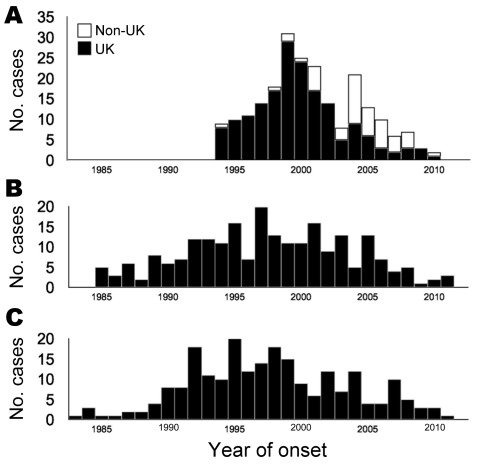Abstract
The book on iatrogenic Creutzfeldt-Jakob disease (CJD) in humans is almost closed. This form of CJD transmission via medical misadventures was first detected in 1974. Today, only occasional CJD cases with exceptionally long incubation periods still appear. The main sources of the largest outbreaks were tissues from human cadavers with unsuspected CJD that were used for dura mater grafts and growth hormone extracts. A few additional cases resulted from neurosurgical instrument contamination, corneal grafts, gonadotrophic hormone, and secondary infections from blood transfusions. Although the final solution to the problem of iatrogenic CJD is still not available (a laboratory test to identify potential donors who harbor the infectious agent), certain other measures have worked well: applying special sterilization of penetrating surgical instruments, reducing the infectious potential of donor blood and tissue, and excluding donors known to have higher than normal risk for CJD.
Keywords: Creutzfeldt-Jakob disease, dura mater, human growth hormone, iatrogenic disease, PRNP codon 129, variant Creutzfeldt-Jakob disease, prions and related diseases
Medscape CME Activity
Medscape, LLC is pleased to provide online continuing medical education (CME) for this journal article, allowing clinicians the opportunity to earn CME credit.
This activity has been planned and implemented in accordance with the Essential Areas and policies of the Accreditation Council for Continuing Medical Education through the joint sponsorship of Medscape, LLC and Emerging Infectious Diseases. Medscape, LLC is accredited by the ACCME to provide continuing medical education for physicians.
Medscape, LLC designates this Journal-based CME activity for a maximum of 1 AMA PRA Category 1 Credit(s)TM. Physicians should claim only the credit commensurate with the extent of their participation in the activity.
All other clinicians completing this activity will be issued a certificate of participation. To participate in this journal CME activity: (1) review the learning objectives and author disclosures; (2) study the education content; (3) take the post-test with a 70% minimum passing score and complete the evaluation at www.medscape.org/journal/eid; (4) view/print certificate.
Release date: May 16, 2012; Expiration date: May 16, 2013
Learning Objectives
Upon completion of this activity, participants will be able to:
Distinguish the principal sources of iatrogenic CJD
Identify countries with the highest rates of documented CJD
Analyze the clinical presentation of iatrogenic CJD
Assess new threats which might promote higher rates of CJD.
CME Editor
P. Lynne Stockton, Technical Writer/Editor, Emerging Infectious Diseases. Disclosure: P. Lynne Stockton has disclosed no relevant financial relationships.
CME Author
Charles P. Vega, MD, Health Sciences Clinical Professor; Residency Director, Department of Family Medicine, University of California, Irvine. Disclosure: Charles P. Vega, MD, has disclosed no relevant financial relationships.
Authors
Disclosures: Paul Brown; Jean-Philippe Brandel; Takeshi Sato, MD; Yosikazu Nakamura, MD, MPH, FFPH; Jan MacKenzie; Anna Ladogana; Ellen W. Leschek, MD; and Lawrence B. Schonberger, MD, MPH, have disclosed no relevant financial relationships. Robert G. Will, FRCP, has disclosed the following relevant financial relationships: served as an advisor or consultant for LFB, Farring. Maurizio Pocchiari, MD, has disclosed the following relevant financial relationships: served as an advisor or consultant for LFB, Farring.
Footnotes
Suggested citation for this article: Brown P, Brandel J-P, Sato T, Nakamura Y, MacKenzie J, Will RG, et al. Iatrogenic Creutzfeldt-Jakob disease, final assessment. Emerg Infect Dis [serial on the Internet]. 2012 Jun [date cited]. http://dx.doi.org/10.3201/eid1806.120116



